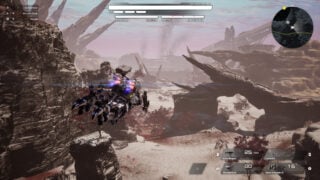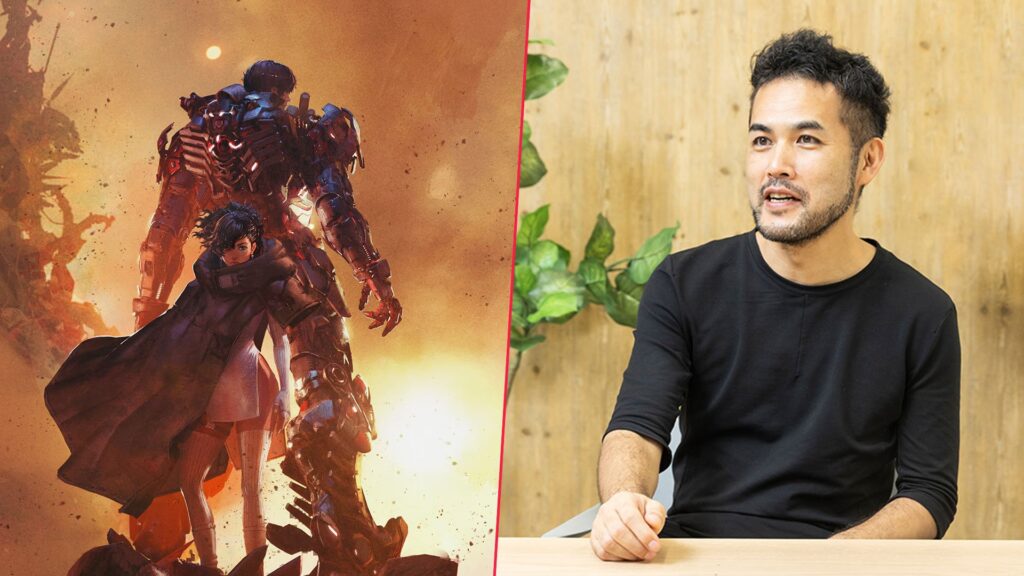GPlayr recently spoke with Kenichiro Tsukuda, the producer of the mech action series Daemon X Machina, to discuss the upcoming open-world sequel Daemon X Machina: Titanic Scion. Tsukuda shared more about the game’s horseback traversal, multiplayer, open world, enemies, overhauled skill system, game length, and more.
Get the full interview below.
Horseback traversal is a new feature. How has this impacted mission design overall? Will there be combat tied to horseback movement, or is it mainly a tool for exploration?
Kenichiro Tsukuda, Series Producer: “Yes, you can engage in combat on horseback. Traveling in your arsenal consumes energy, but you don’t consume energy when riding a horse or other using other vehicles. It’s also fun to travel around with friends, whether that’s by flying or by utilizing vehicles. I believe horses do not detract from the sci-fi or mech genres in any way, as they have long-existed in sci-fi novels, and I believe they are actually necessary to pay respect to the novelists who pioneered this genre.”
With co-op confirmed for the main campaign, can the full story be played through with three players? Or are there limitations to which missions support multiplayer?
Tsukuda: “There are no restrictions at all. Everything is playable in co-op. However, while players at a higher levels can sync to those at a lower level, lower-leveled players will not be able to join the games of higher-leveled players. This is because most players prefer to avoid spoilers and don’t want to jump ahead in the story.”
Asynchronous multiplayer is also new to the series. Can you elaborate on how it functions? Will players encounter shared events, custom challenges, or ongoing threats?
Tsukuda: “The entire story can be enjoyed in co-op, so you can face all enemy threats and in-game events with other players. Through asynchronous multiplayer, players can create bases in the open world that other players can interact with. You can access the same functions at these bases out in the field as you would be able to at your own home base. Additionally, if you find another player’s wreckage out in the world, you can obtain items or equipment from them. The player who fell in battle doesn’t lose these items if another player takes them. This means that even if you die in the game, you’ll still be helping someone out, which makes for a more carefree and enjoyable experience. There are other features as well, but we’ll discuss those at another time.”
The game is described as featuring a “vast” open world. How does this approach contrast with the mission-based structure of the original? Are there dynamic encounters like world bosses, faction-controlled zones, or other random objectives? And how do you ensure the world feels alive, avoiding the emptiness seen in parts of the first game?
Tsukuda: “Players can look forward to encountering random missions and events in the open world, and it’s great to explore as well. We designed it more like an RPG, really. Even weak enemies often drop new items, so there’s always excitement in finding new enemies. As a game centered around combat, Titanic Scion always has something in store that makes you want to keep progressing.
“And exploration is more than just seeing what’s around the next corner. You can do things with other players like share secret maps with each other that I hope will lead to more players wanting to play co-op with their friends.”
You’ve mentioned the addition of organic enemies. Are these a completely new class of enemy? How do they differ from mechanical enemies in terms of strategy, behavior, or vulnerabilities?
Tsukuda: “They are indeed a new type of enemy. However, they are not entirely organic. They are the result of mechanical entities repeatedly fusing with biological organisms. Enemy behavior and weaknesses are individually set for each enemy, so rather than saying organic enemies are different from mechanical enemies, it’s more accurate to say that each enemy is unique. However, as a general rule, mechanical enemies are weak against energy-based weapons like lasers, while biological enemies are weak against projectile-based weapons.”
Can players expect any new customization features that go beyond what was possible in the original? Are there any new systems added to the mech building?
Tsukuda: “One addition is that you can now create your own emblems, which opens up new ways to play. For example, you can create a ‘team’ emblem with friends in the new and improved online mode. Additionally, while not necessarily a customization feature, you can now carry items that boost attack power and healing, making the game more accessible for beginners in a group. In terms of customization for your Arsenal, there are now more weapons available to equip, along with changes to equipment slots, new weapon types, and additional functionalities based on different weapons. These all add more depth to customization.”

The visual style seems to be more realistic this time around, compared to the more heavily cel-shaded look of the original. Was this shift primarily to support a darker narrative tone, or were there other design / technical factors at play?
Tsukuda: “I thought a lot about our visual aesthetic. While the first Daemon X Machina had an anime-style aesthetic, this one adopts techniques closer to Japanese manga, specifically Gekiga, with some photorealism influence as well. The characters are more manga-inspired, while the mecha designs lean toward photorealism. Because we are releasing on multiple platforms, we aimed to appeal to a wide audience, including anime and manga fans, and fans of the first game.”
The Axiom are introduced as new antagonists. While avoiding any major spoilers, how do they compare to the Immortals in terms of goals, combat style, or threat level?
Tsukuda: “Compared to regular small enemies, Axiom Soldiers often appear in groups and can be quite challenging until you’re properly equipped. Additionally, bosses like the Neun use special skills that are far more advanced than the mercenaries from the first Daemon X Machina, so be careful when challenging them. Of course, defeating them allows you to obtain the powerful skills they use.”
Are skills a brand-new progression layer—such as a dedicated skill tree—or do they build on the existing augment system from the original?
Tsukuda: “We completely overhauled the skill system. Instead of a skill tree, you acquire and equip skills through factors and genetic patterns obtained by defeating enemies. These skills are divided into two types. Active skills are used during combat and function similarly to spells or special moves in an RPG, while passive skills enhance your physical prowess. Of course, the augmentation system for armor and weapons is still present as well.”
In terms of narrative length, how does this entry compare to the roughly 15-hour runtime of the original game?
Tsukuda: “For all but the most hardcore players who may be able to speed through the story, playing the entire game will require acquiring proper equipment. The process of gearing up and becoming stronger is a core fun element of this game, after all, so it should take players longer to play through this game than the first Daemon X Machina.”
Is there a final message you would like to share with the GPlayr audience before you sign off from this interview?
Tsukuda: “Even within the sci-fi genre, the mech subgenre can be viewed as quite niche. However, to those who may not have considered mech games before, Titanic Scion offers appealing characters, a helpful community through online co-op, and an RPG-inspired design that allows players to overcome challenges not just through action alone, but by exploring the world and upgrading their equipment. My goal for Titanic Scion was to create a mech game that even beginners would enjoy. This game will release on multiple platforms, so please give it a try!”
Daemon X Machina: Titanic Scion is due out for PlayStation 5, Xbox Series, Switch 2, and PC via Steam on September 5 worldwide.


